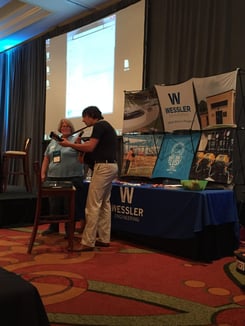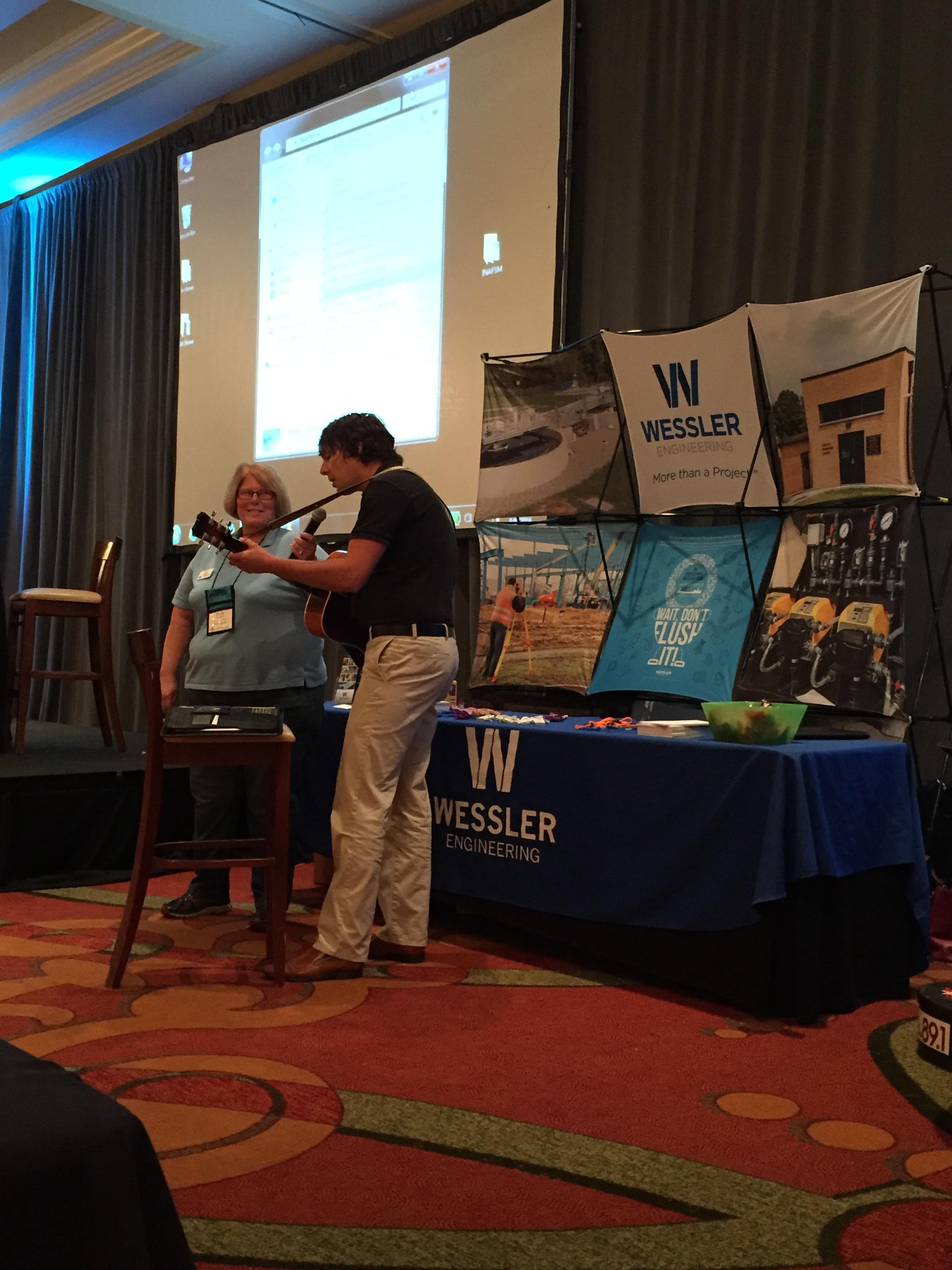The 2016 Annual Conference of the Indiana Association for Floodplain and Stormwater Management, Inc.,  celebrating 20 years of commitment to floodplain and stormwater management, included more than 40 learning and plenary sessions, field trips, and networking opportunities. The presentations were divided into four learning tracks: Floodplain, Technical, MS4, and Stormwater. Throughout all tracks, education and outreach, low impact development, and a push towards green infrastructure were reoccurring themes.
celebrating 20 years of commitment to floodplain and stormwater management, included more than 40 learning and plenary sessions, field trips, and networking opportunities. The presentations were divided into four learning tracks: Floodplain, Technical, MS4, and Stormwater. Throughout all tracks, education and outreach, low impact development, and a push towards green infrastructure were reoccurring themes.
Greenwood’s Fry Road Rain Trail
by Bill Leber – Wessler Engineering
The existing stormwater conveyance system along Fry Road, just West of U.S. 31 in Greenwood, Indiana, consisted of failing pipes and an open ditch. Rather than placing reinforced concrete pipe and filling in the ditch, Wessler Engineering and the City of Greenwood developed what has been designated as the “Rain Trail”. The Rain Trail is a multi-use trail incorporating a porous asphalt surface, which allows stormwater runoff to infiltrate through to the aggregate recharge bed and underdrain below. The infiltration of the runoff slows the flow of runoff, reducing peak flows and flooding risks, as well as increasing the efficiency of the water supply system by allowing stormwater to recharge groundwater. The Rain Trail promotes pedestrian traffic while providing green infrastructure benefits for the cost of traditional infrastructure implementation.
Subsurface Gravel Wetlands for Management of Stormwater Runoff
by Dr. Thomas Ballestero – University of New Hampshire Stormwater Center
The effects contaminated stormwater can have on the environment is a major concern and should not be ignored. While investigating treatment options for the stormwater of today, Dr. Thomas Ballestro looked to wastewater treatment technologies of the past. Constructed wetlands were actually first used to treat wastewater. The first utilization of this technology in the U.S. was implemented in the 1980s. Although insufficient in targeting all contaminants found in wastewater, this approach is more than adequate in reducing key contaminants found in stormwater. Key contaminants include nitrogen, phosphorus, suspended solids, and metals. The design utilizes subsurface gravel layers that create an anaerobic zone for the denitrification process to occur. The layer above the gravel is constructed as a typical constructed wetland. The difference between subsurface gravel wetlands and the majority of infiltration technologies is that the flow path is horizontal instead of vertical. The horizontal flow path is longer, which increases the detention time and, as a result, the overall water quality is substantially improved.
Stormwater Education and Outreach: 3 Creative Methods for Implementation
by Kriste Lindberg – City of Bloomington Utilities Department; Jason Donati – Muncie Sanitary District/Stormwater Management Department; Monica Christopher and Vanessa Rainwater – Tippecanoe Co. Partnership for Water Quality
Education and outreach to our communities is a significant factor in minimizing stormwater impacts. Kriste Lindberg from the City of Bloomington Utilities Department explained how a class of students at Indiana University helped to improve the stormwater quality within their community. "G201 – Service Learning in Chemistry, Water Quality Monitoring" taught students the importance of water quality through chemistry, water sampling and community service. Jason Donati from the Muncie Sanitary District developed a free day camp called Camp Prairie Creek where students from 1st to 8th grade learn about the importance of protecting the environment through hands-on activities. Monica Christopher and Vanessa Rainwater from Tippecanoe Co. Partnership for Water Quality also shared their programs and success in community engagement. Their programs get students invested in the importance of water quality through interactive methods, such as pretending to be a water drop, chemical water testing, and raft trips along the Wabash River.
Stormwater Capture and Reuse: Passive Irrigation for Pervious Pavements
by Jim Blazek – D2 Land & Water Resource, Inc.
The push towards low-impact development and green infrastructure is increasing as both awareness and regulations are also on the rise. IndyFringe, located along the cultural trail in Indianapolis, Indiana, incorporated green infrastructure into their plan to expand their building and construct a new parking lot and adjacent alley. Instead of the typical, impervious asphalt parking lot, a grass pavement parking area was designed and installed to capture the runoff from the roof and alley. The design includes an underground storage system that captures the site’s runoff, stores and reuses the stored water for passive irrigation of the grass layer above. The grass layer incorporates a GEOBLOCK® system that provides support for a variety of loadings while preventing soil compaction and allowing grass growth within each block. The design resolved the flooding issues while having promoted stormwater reuse.
Floodplain Restoration via the Two-stage Ditch Alters Nutrient Export from Agricultural Watersheds
by Dr. Jennifer Tank – University of Notre Dame
The two-stage ditch is an effective design because it mimics natural streams. It also provides low flow channel for the majority of the flow. During less frequent substantial storm events, the flow elevation exceeds the channel bench and spreads to a designed floodplain width. The extended width (second stage) of the ditch provides a much higher nutrient removal because of the increase in surface area. Research completed on the Shatto Ditch in Kosciusko County, Indiana showed floodplain restorations, through the implementation of the two-stage ditch, resulted in increased nitrogen removal and reduced the transport of sediments to downstream waterways. Although successful in the removal of nitrogen and sediments, inorganic phosphorus loading changes were negligible. During the study, a model was developed, which suggested that the longer the two-stage ditch implementation, the more effective in removing nutrients from the agricultural runoff.

In addition to all of the new technologies, services, regulatory updates, and exchanging of ideas, we also learned our talent at Wessler reaches beyond engineering. Our own Andrew Gordon wrote and performed a song explaining all that we do here at Wessler Engineering in regards to stormwater and floodplain management. Check out the video below!
Overall, the 20th Anniversary of the INAFSM conference was a success, where we enjoyed our time learning and networking with colleagues throughout Indiana and beyond.
Tags

